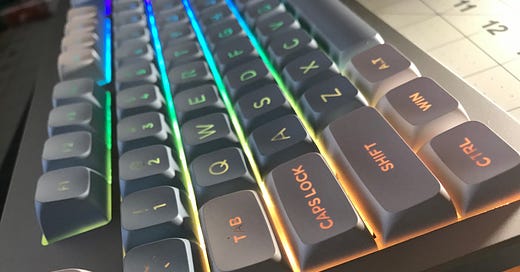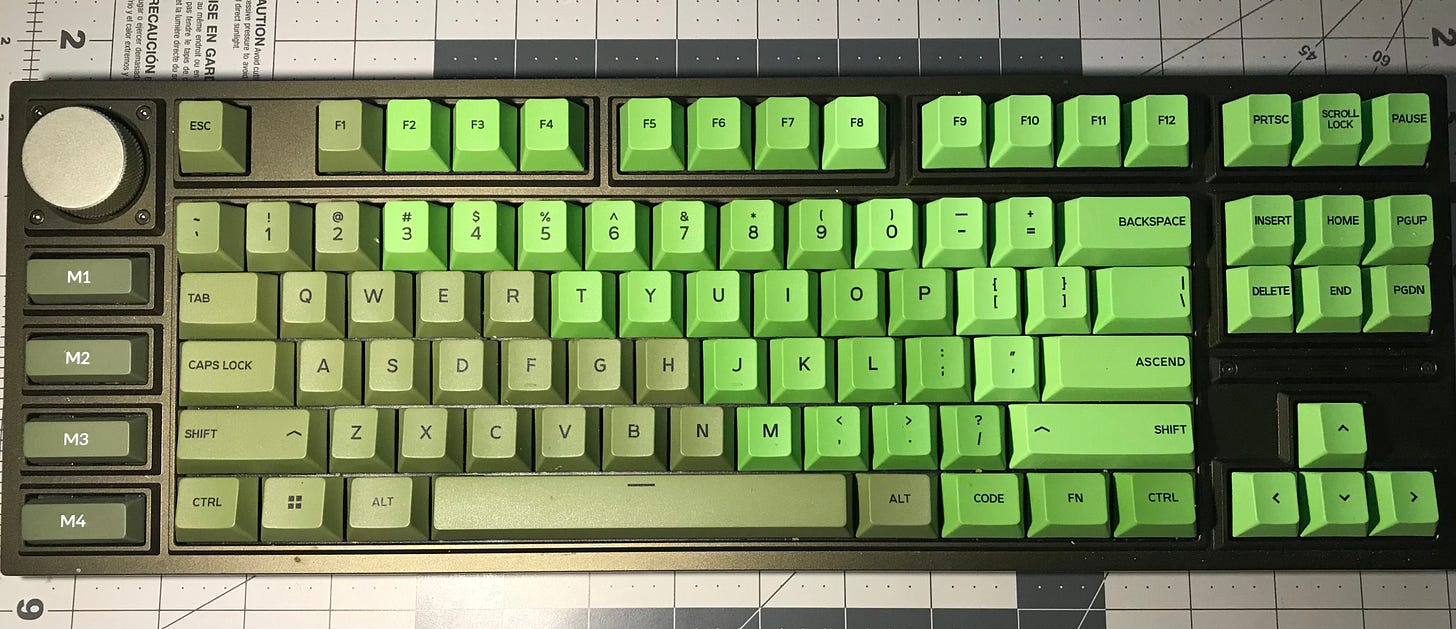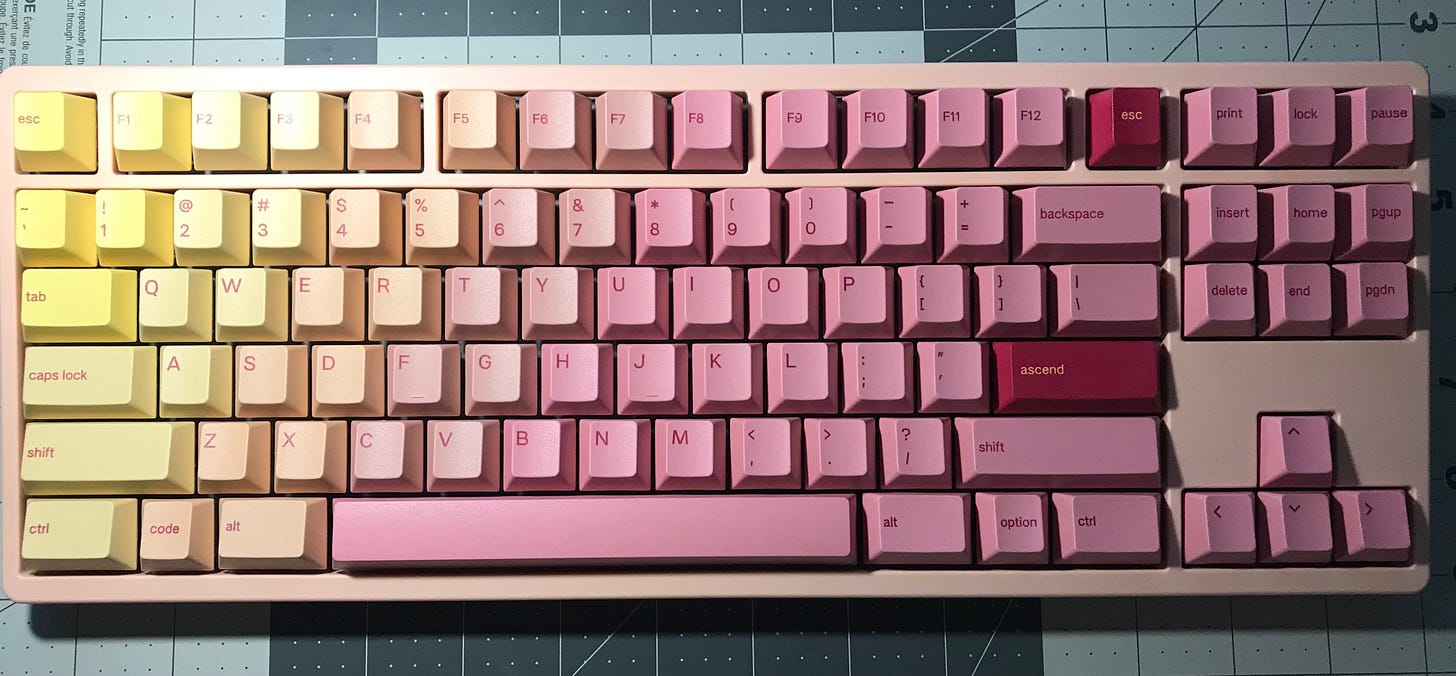A PRIMER ON MECHANICAL KEYBOARDS, FOR CASUALS, PART 3: Making actual recommendations
It's gonna be Keychron, mostly
Now that I’ve covered the groundwork for mechanical keyboards as a concept in part 1 and covered basic keyboard terminology in part 2, I suppose I am forced to make actual purchase recommendations. I continue to assert that mechanical keyboards are not essential and largely overrated outside of certain specialist applications (special ergonomic requirements, rigorous macro utilization, etc). That being said, a solid mechanical keyboard is not much more expensive than the average AAA video game title (as of 2023), and may meaningfully improve an often-neglected part of the home office experience.
Whether you are looking at a keyboard for gaming, typing, or just as a new hobby to get into, the keyboards I would recommend remain more or less the same. If you had a particular preference for specific features that would severely restrict your options, you would likely be knowledgeable enough on keyboards to not need this article anyway. Most keyboard users, even those who use them on a daily basis, do not use any features outside of what is printed on the buttons. As such, a $10-$15 fullsize membrane keyboard with no additional features will be the baseline from which I step off from.
FEATURES I WOULD RECOMMEND ACROSS ALL USE CASES
Standard Hotswap Sockets:
This also means compatibility with Cherry MX-type switches, which are the only standard which is in common usage. This feature is a quality of life thing, as it future-proofs your keyboard and allows you to experiment with switches down the line. Avoid Outemu brand sockets because they are built to different specifications which limit your choice in switches, and using the wrong type of switch in these sockets can damage them. Standard sockets, usually made by Kailh or Gateron, are compatible with everything. The keyboards I recommend in this article will all have standard sockets.
Screw-in stabilizers:
These are not essential. However, if you’re going through the hassle of buying a mechanical keyboard, it makes sense to get one that feels better to type with. Solid stabilizers do feel better than rattly ones, and screw-in stabilizers are most likely to be solid.
Software support, and specifically VIA compatibility:
While most people will not utilize software, having it available opens the avenue to experimenting with macros or function layers down the line. If invested in, software can be a huge boost to productivity. I suggest VIA because it is more or less standard, and I can’t guarantee the capability of software I have no experience in.
South-facing RGB:
This is another compatibility feature. Cherry profile keycaps are the most common on the market, so if at any point you decide to buy a new keycap set having south-facing switches will eliminate the guesswork as to whether they will fit. As for RGB, it’s just kinda neat. Almost every “custom” mechanical keyboard has it, so why not?
FEATURES WHICH MAY DEPEND ON USE CASE
Layout:
This is one of the factors which can vary the widest based on individual need. The numpad is fairly obvious, as those who need it are acutely aware of that fact. The function row, home section, and arrow keys are necessary for those who do utilize it. Generally, if you can remember using it in the last day or two, you should have it on your keyboard.
Popular variant layouts like 75% (a variant of TKL) or 65% (between 75% and 60%) are, in my opinion, primarily for style. These layouts are significantly less standardized and can cause issues with finding compatible keycap sets. It is my opinion that these are a bit dumb, but their continued popularity proves I’m a luddite.
If you need a numpad, get a fullsize keyboard.
If you don’t need a numpad, get a TKL.
If you are confident you don’t need a numberpad, the function row, home section, or arrow keys, get a 60%.
If you need the features of a TKL but want something different, and are willing to put up with the peculiarities of the layout, you can consider a 75%. Keep in mind that even between 75% boards the size and location of the home section can vary widely or even require proprietary keycap sizes. Compare images of the board with the layout page of the keycaps you intend to use before buying either.
If you want a 60% but need arrow keys, or want a 75% but don’t need the function row, you can consider a 65%. Keep in mind that even between 60% boards the size and location of the home section can vary widely or even require proprietary keycap sizes. Compare images of the board with the layout page of the keycaps you intend to use before buying either.
If you want something else, do the research and make sure you can accept the layout. Alice in particular has very specific keycap set requirements.
Wireless
If you have a need or desire for a wireless board, be aware that both wireless and Bluetooth boards exist, and that some boards come with both (and also include a backup wired mode, but this is not always the case). If you don’t need wireless but the board you are looking at has it, consider the potential hazards involved with a battery being constantly plugged in.
Mounting Style
This is one of the biggest decisions to consider, as the existence of the tray mounted Keychron V series makes “upgrading” to a gasket mount constitute a significant jump in price. While mounting style is technically personal preference, gasket mount keyboards continue to be preferred by the “enthusiast” crowd. Gasket mount keyboards do feel substantially different, but it is questionable whether seeing what this difference feels like is worth adding an additional $50 or more to your total cost.
If you want to see what the hype is all about, get a gasket mount.
If cost is a major consideration, or you don’t care, get a tray mount or whatever is cheaper.
Premade VS Barebones/Kit
If you know what you want (I.E. you have a specific switch and keycap set you know you want to use), you can consider a barebones/kit. Otherwise, the additional value of a completed board for such a small increase in cost is hard to ignore.
If you are the intended audience for this article, just get a premade (the one with keycaps and switches that comes assembled).
Knob/Encoder
If you want one, get it.
The non-exhaustive list of “custom” keyboards that would be alright, if you were committed to buying one.
I own all of these. They all have the good hotswap sockets and have VIA compatibility, and as far as I am aware are an in-stock (no preorder/GB necessary). I’m posting images of my boards primarily as proof that I actually own them so as to counter any accusations that this is a cheap listicle. The boards are kitted as I use them currently.
Keychron V
Available Layouts: 60%, 65%, 75%, TKL, Fullsize, etc
Case Material: Plastic
Mounting Style: Tray
Plate Material: Steel
Wireless? NoStabilizer Type: Screw-in
RGB/Backlight: Per-key RGB
Prebuilts Available? Yes
Cost (On Amazon): $70-$105 depending on layout, prebuilt or barebones, etc
Carrying Case? No
Discussion: This is, somewhat unfortunately, the value proposition to beat. No keyboards offer this combination of features at this price range. VIA compatibility, screw-in stabilizers, dampening materials, Full RGB backlighting, and pre-built options are not common at all to find together at this price. They’re very popular and have solid documentation online, and are even available on Amazon. As far as I am aware, there are no easier recommendations to make at this price range. The Keychron V series is the absolute “no questions asked” recommendation. As much as I’d like to say there are alternatives, you need to be willing to pay a lot more to get something even slightly better without taking risks on small brands on overseas websites with questionable product support.
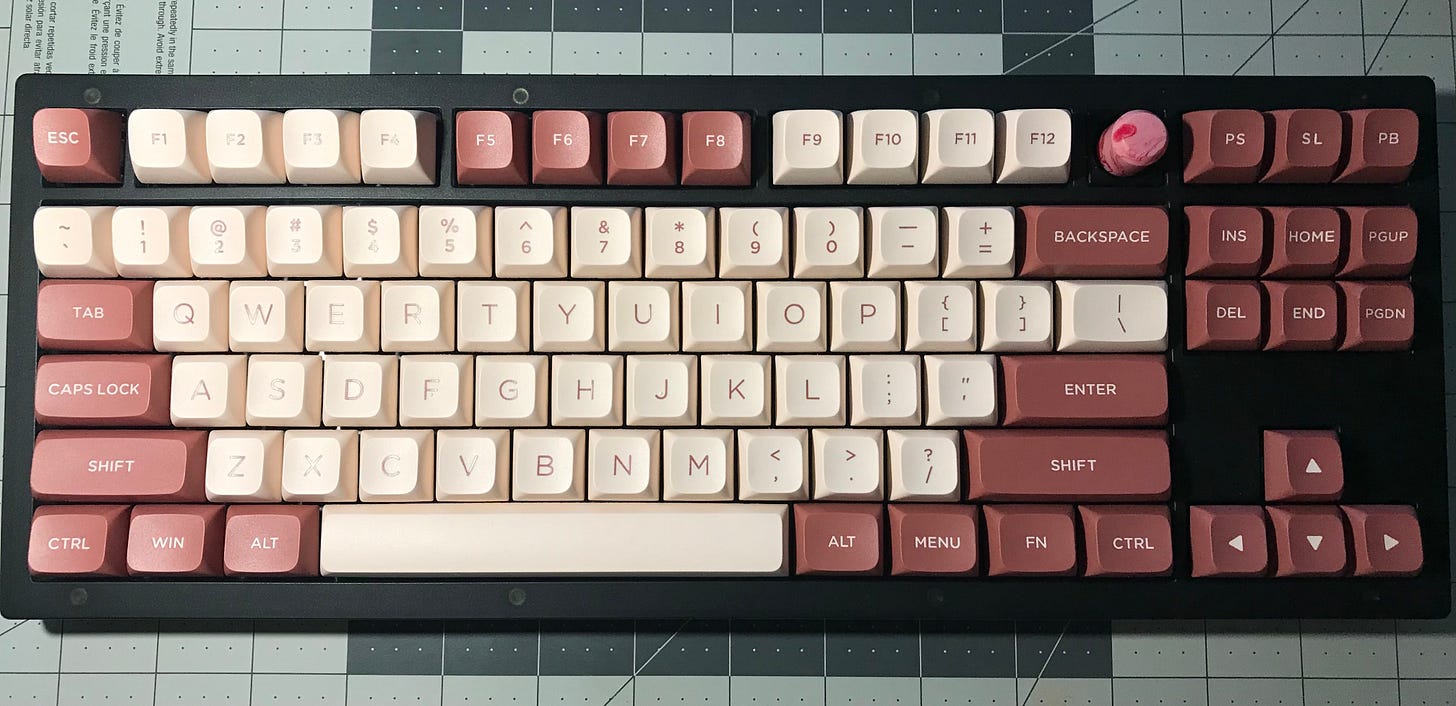
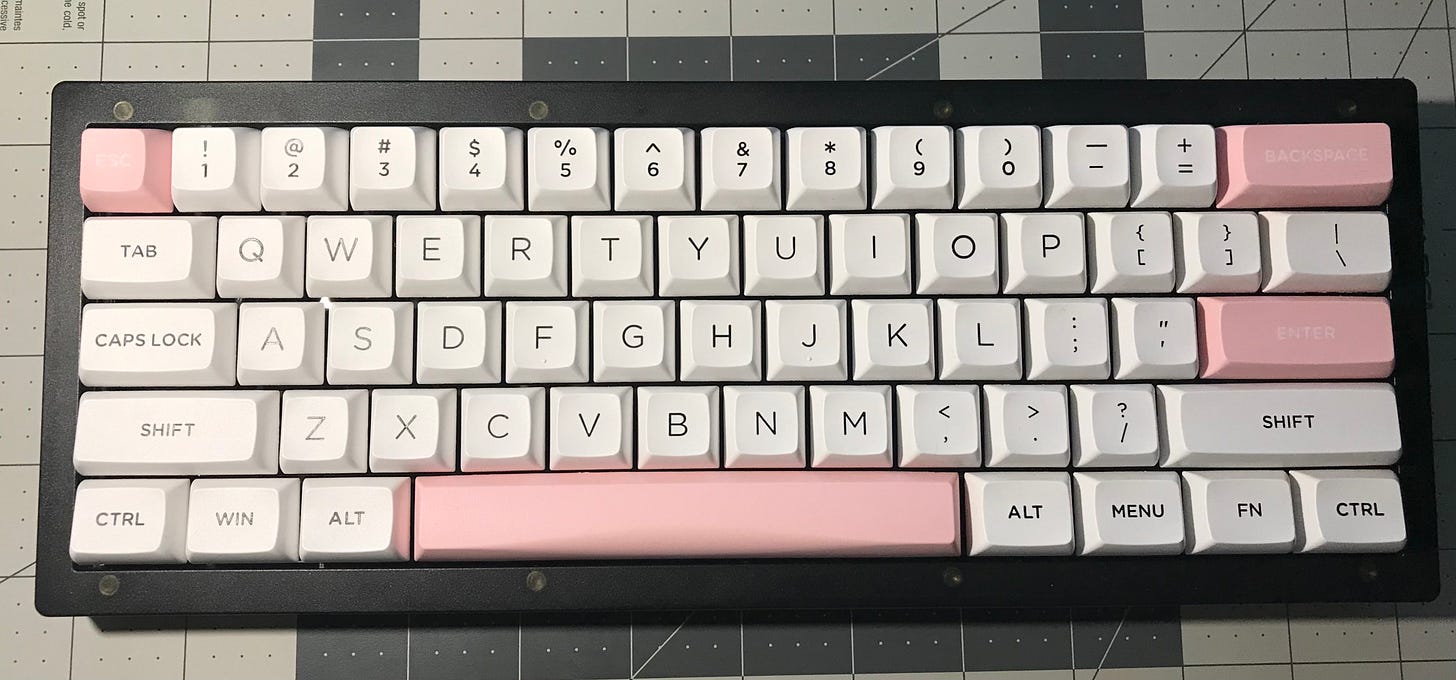
Keychron Q
Available Layouts: 60%, 65%, 75%, TKL, Fullsize, etc
Case Material: Aluminum
Mounting Style: Gasket
Plate Material: PC (Polycarbonate)
Wireless? Only in Pro versionsStabilizer Type: Screw-in
RGB/Backlight: Per-key RGB
Prebuilts Available? Yes
Cost (On Amazon): $180-$220 depending on layout, prebuilt or barebones, etc
Carrying case included? No
Discussion: The cost raises an eyebrow given the competition available now, but it remains a no-nonsense aluminum gasket board available in premade options. It is, however, feature-wise identical to the V series, so the significant additional cost is only for changing the mounting style, plate, and case. The Pro versions add wireless, and with the exception of the Q3 Pro are otherwise very similar to their standar equivalents. If you want something that is “premium” and functions out of the box, the Keychron Q is a decent option.
Monsgeek M
Available Layouts: 75%, TKL, etc
Case Material: Aluminum
Mounting Style: Gasket
Plate Material: PC (Polycarbonate)
Wireless? Only in W versions (limited availability at the moment)Stabilizer Type: Screw-in
RGB/Backlight: Per-key RGB
Prebuilts Available? No
Cost (On Divinikey): $120-130
Carrying Case? No
Discussion: Feels like a Keychron Q, basically. It comes assembled besides the stabilizers, which actually means you need to disassemble it to get them installed. It looks like an aluminum block, which I like, and comes with additional rubber (?) stickers to mitigate case ping. Removing keycaps can sometimes pull switches loose. There’s an accent piece which shows through the side of the case, and I have removed this so the RGB can shine through the side. If you don’t mind losing a knob on the TKL version and prefer the case color/shape the Monsgeek M can save you a significant amount of money.
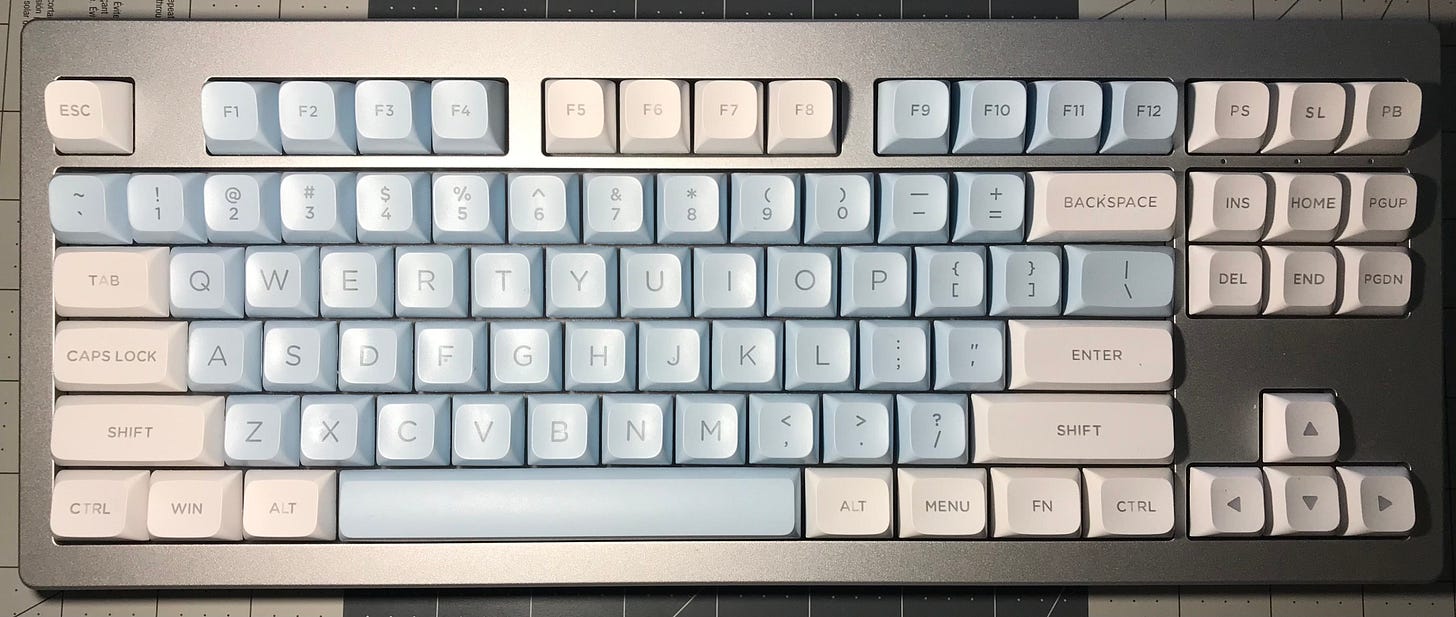
Bakeneko
Available Layouts: 60%, 65%
Case Material: Aluminum
Mounting Style: Gasket (O-ring)
Plate Material: FR4 Fiberglass
Wireless? NoStabilizer Type: Clip-in
RGB/Backlight: No
Prebuilts Available? No (Bundle discount on keycaps)
Cost (On CannonKeys): $130-$135 plus shipping
Carrying Case? Yes
Discussion: The pretentious “enthusiast” choice. It has all the premium label features (O-ring gasket mount, aluminum case in a variety of colors) which also happen to make it more of a pain in the ass to mess around with. The FR4 plate is very tight, and I have damaged a number of switches in the process of pulling them out of the plate. The clip-in stabilizers can pull themselves loose when removing keycaps, and on my copy the R key is slightly lower than all the other keys. I also don’t think it generally sounds or feels nice to type with, but I have gotten something kind of neat using Gateron Yellows and SP SA-P keycaps (a set which costs about the same as the board itself). That being said, I have peculiar tastes, so you might still like the Bakeneko. There’s nothing functionally wrong with it.
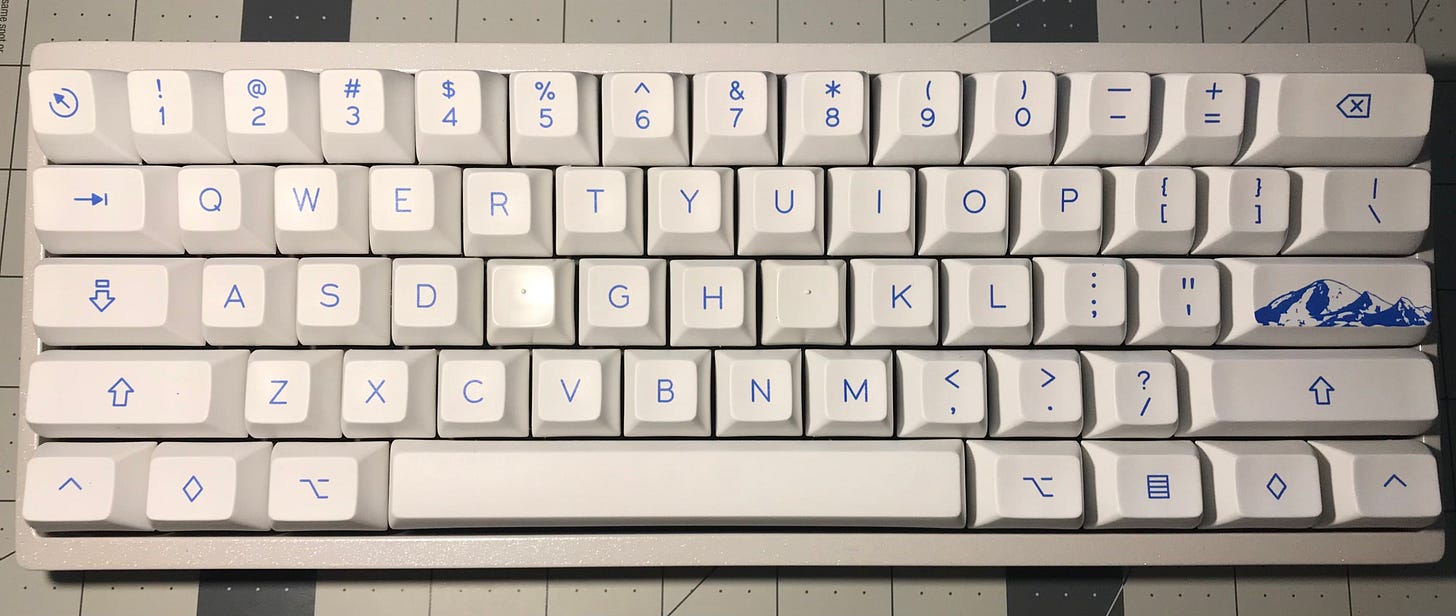
Tiger Lite
Available Layouts: TKL
Case Material: ABS Plastic
Mounting Style: Gasket
Plate Material: PC (Polycarbonate)
Wireless? NoStabilizer Type: Screw-in
RGB/Backlight: RGB underglow only
Prebuilts Available? No
Cost (On Kinetic Labs): $120 plus shipping
Carrying Case? Yes
Discussion: Maximum jank and maximum flex. It’s a cost-reduced version of a board with an aluminum or acrylic case, and the transition to an ABS plastic case has given the board more internal volume. Enough internal volume, in fact, that if you press hard enough for the PCB to flex all the way, the switches in the top corners of the board pull out of their socket. You won’t press that hard on your board when typing normally, but if it does happen you have 10 screws to disassemble. The gasket socks need fiddling to seat, the switch pad doesn’t have openings for the hotswap sockets meaning that it’s hard to tell if your switches are aligned when inserting, and the underglow isn’t visible if you have an opaque case. That being said, this is probably the flexiest keyboard commonly available. Nice additional features like extra colored cases (questionable availability) and brass threads sunk into the plastic components make tweaking this board a safe, if somewhat time-consuming, affair. The included foam and tape mod options are good for this too. Overall, the Tiger Lite seems good for someone who wants a keyboard as a hobby more than as a tool. Oh, and the 7u bottom row is a pain. (Geonworks offers a 6.25u bottom row PCB, but shipping from South Korea is expensive and limits the possibility of RMAs, service, etc).
There are other keyboards out there that are probably pretty good. Gaming company boards are hard to gauge because of their proprietary software, weird layout (bottom rows or shift key sizes that no one else uses), and the fact that they are often unable to be disassembled. Since they’re intended for casuals, their specification pages might not give important information, and even their “enthusiast” options tend to be overpriced for the features they offer. Plenty of smaller overseas brands make decent stuff, but shipping cost and difficulty in finding documentation (in American) make them hard to recommend to a casual.
Conclusion
I promise that I’m not a shill for Keychron. They just inhabit a niche that is hard for anyone else to dislodge them from. Smaller companies can’t compete in price, as Keychron makes somewhat boring custom-featured boards at scale, and larger companies don’t want to enter the custom market because they’re too busy overcharging on “gaming” keyboards. That leaves the Keychron V, especially now that their products are available on amazon and at brick-and-mortar computer stores, as the clear leader in the budget custom keyboard segment.
It would be nice if they were available in different colors, though.

